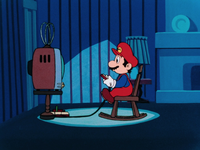Family Computer: Difference between revisions
No edit summary |
mNo edit summary |
||
| Line 10: | Line 10: | ||
The '''Famicom''' ('''Fami'''ly '''Com'''puter) is the Japanese equivalent of the [[Nintendo Entertainment System]], or the NES. The Famicom's controllers were attached to the main unit, unlike the NES, and could be stored on the sides of the system. Player One's controller can pause the game, and Player Two's controller has audio controls. The cartridges were half the size of the NES', and were inserted in the top instead of through a door in the front (like on the NES). Instead of looking like a vertical cartridge, like the NES, it more closely resembles a [[SNES]] cartridge, but can be found in different colors, such as gray, yellow, and blue. | The '''Famicom''' ('''Fami'''ly '''Com'''puter) is the Japanese equivalent of the [[Nintendo Entertainment System]], or the NES. The Famicom's controllers were attached to the main unit, unlike the NES, and could be stored on the sides of the system. Player One's controller can pause the game, and Player Two's controller has audio controls. The cartridges were half the size of the NES', and were inserted in the top instead of through a door in the front (like on the NES). Instead of looking like a vertical cartridge, like the NES, it more closely resembles a [[SNES]] cartridge, but can be found in different colors, such as gray, yellow, and blue. | ||
The console was released in 1983, but in February 1986 the [[Famicom Disk System]] was released as an accessory for the Famicom. This accessory enabled games to be played on the Famicom in the form of a disk. Many newer games were released only on the F.D.S. that were never released on the NES or Famicom. [[wikipedia: Sharp Corporation| Sharp Corporation]] also manufactured the Twin Famicom, an NES (Famicom) combined with a Famicom Disk System in one piece of hardware, but it was only released in Japan. | The console was released in 1983, but in February 1986 the [[Famicom Disk System]] was released as an accessory for the Famicom. This accessory enabled games to be played on the Famicom in the form of a disk. Many newer games were released only on the F.D.S. that were never released on the NES or Famicom. [[wikipedia: Sharp Corporation|Sharp Corporation]] also manufactured the Twin Famicom, an NES (Famicom) combined with a Famicom Disk System in one piece of hardware, but it was only released in Japan. | ||
==Trivia== | ==Trivia== | ||
Revision as of 04:45, July 28, 2011
Template:System-Infobox Template:LLQuote
The Famicom (Family Computer) is the Japanese equivalent of the Nintendo Entertainment System, or the NES. The Famicom's controllers were attached to the main unit, unlike the NES, and could be stored on the sides of the system. Player One's controller can pause the game, and Player Two's controller has audio controls. The cartridges were half the size of the NES', and were inserted in the top instead of through a door in the front (like on the NES). Instead of looking like a vertical cartridge, like the NES, it more closely resembles a SNES cartridge, but can be found in different colors, such as gray, yellow, and blue.
The console was released in 1983, but in February 1986 the Famicom Disk System was released as an accessory for the Famicom. This accessory enabled games to be played on the Famicom in the form of a disk. Many newer games were released only on the F.D.S. that were never released on the NES or Famicom. Sharp Corporation also manufactured the Twin Famicom, an NES (Famicom) combined with a Famicom Disk System in one piece of hardware, but it was only released in Japan.
Trivia
- In Super Mario Bros.: Peach-hime Kyushutsu Dai Sakusen!, Mario himself (during his days in the Real World early in the movie) owns a Famicom, on which he plays an unknown game. Peach and Bowser also manage to teleport through the television Mario is using, although they do not appear to have any role at all in the game.
